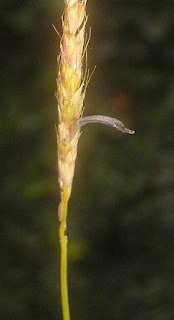There are two main symptoms of ergotism. There are convulsive symptoms that range from mild such as headaches, nausea, diarrhea, and vomiting, to severe: spasms, mania, and psychosis. There is also a set of gangrenous symptoms because of the vasoconstrictive nature of ergot: loss of circulation in the fingers and toes that can lead to loss of the fingers and toes themselves.
Ergot could also affect the nervous system and make the sufferer feel sensations on the skin without any external source. In the Middle Ages this was called St. Anthony's Fire.
Although ergot could infect other grains, rye was the likeliest source in the Middle Ages. Rye was considered a less desirable grain for bread than wheat, and was therefore the grain of the poor—which covered most of the agricultural population. Grains infected with ergot are darkened. Ergot-infected grains in a bushel of wheat would stand out from their color and could easily be picked out. The darker rye would more easily hide the infected grains, especially once it was ground into flour.
Medieval doctors had no cure, and so people turned to divine intervention. The 12th-century chronicler Geoffroy du Breuil recorded outbreaks in the Limousin region of France, where cures were attributed to Saint Martial. An outbreak in Paris in 1129 was cured by relics of St. Genevieve.
Ergot's life-cycle starts in the ground. The spores that produce ergot can survive for one year, and cannot germinate if buried more than an inch below the surface. As it turns out, simple crop rotation, that puts a non-grain crop in a field that held a grain, can cause the ergot present to die out without a host. Also, this post (from almost exactly 10 years ago) explains how the mouldboard plow was better at turning over the heavy soil of Europe, which could help to bury the spores deep enough to prevent germination.
In the words of the sixteenth-century physician Paracelsus. “All things are poison, and nothing is without poison: the dose alone makes a thing not poison.” Claviceps purpurea has produced other compounds thanks to modern science. Ergotamine, for instance, is used for the treatment of migraines because of its vasoconstrictive ability. The drug LSD was synthesized in 1938 from lysergic acid, which is derived from ergotamine.
Because a cure was attributed to St. Anthony, a hospital was founded in his name to treat others. Let me tell you tomorrow about the Hospital Brothers of Saint Anthony. See you then.

No comments:
Post a Comment
Note: Only a member of this blog may post a comment.